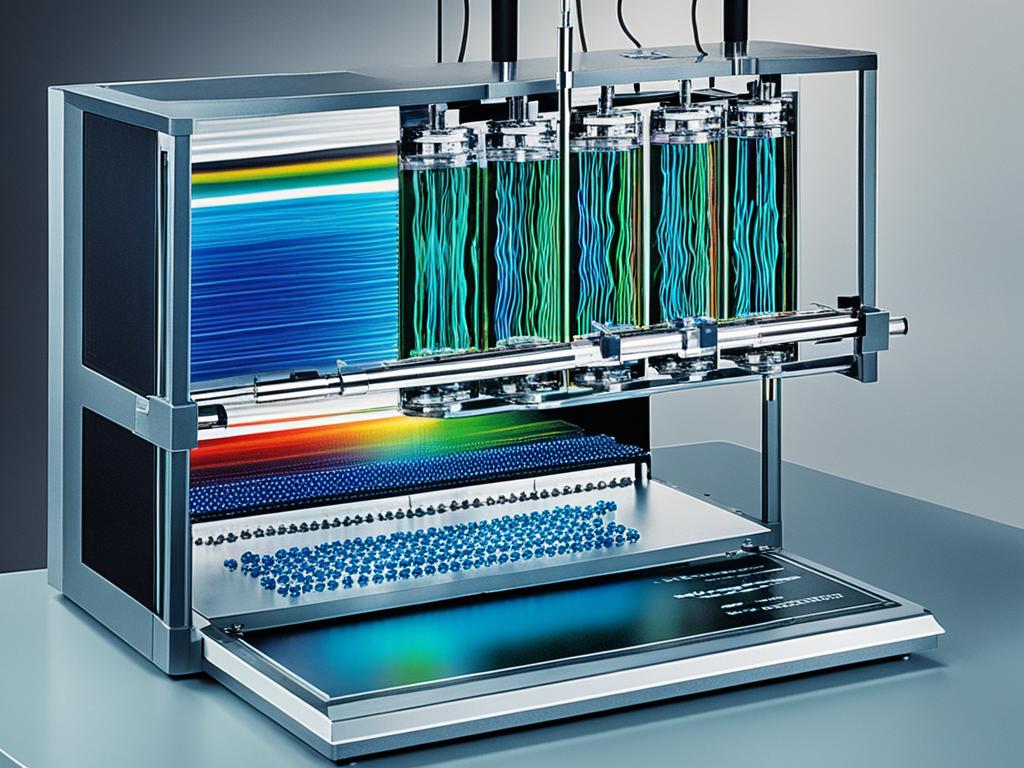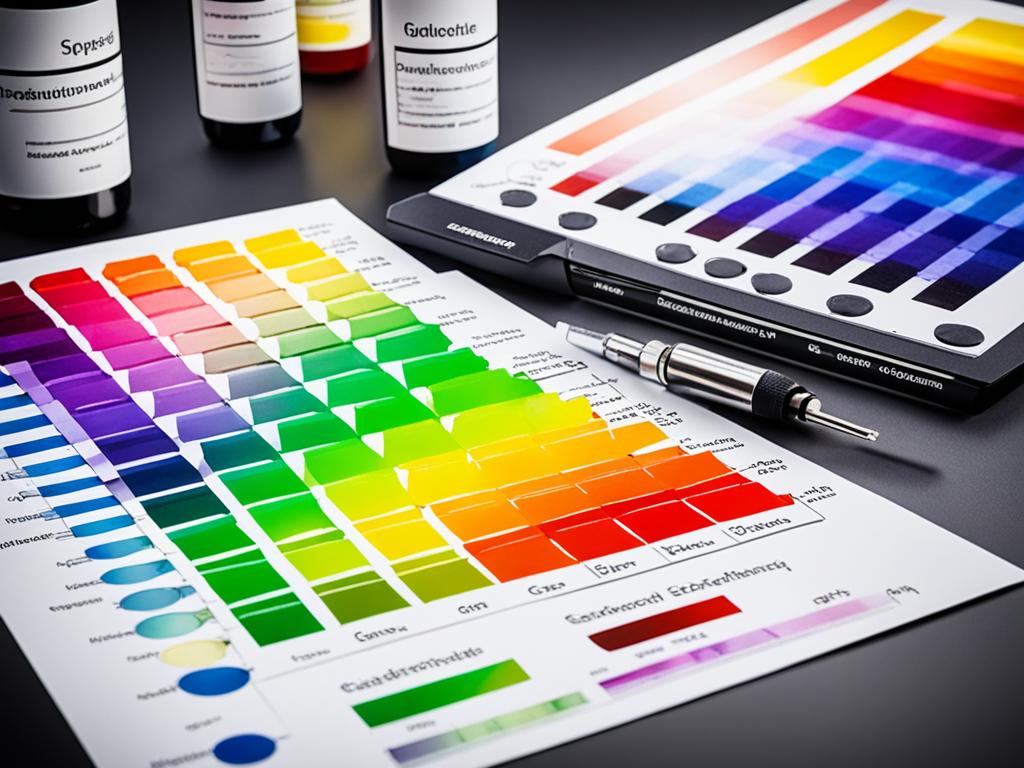Spectroscopy covers many aspects and uses various tools. It looks at how materials react to different radiation frequencies. This study method is key in science, helping in areas like identifying materials or exploring space and health. It groups methods by the radiation type or the material it looks at.
Research in spectroscopy played a big part in making the first atomic models. These models use hydrogen’s spectra to explain. This study is used widely; in chemistry, it helps find and measure atoms, as each one has a unique spectrum.
Spectroscopy also goes beyond the lab. It’s key in astronomy and helps us learn about planets and stars from far away. By looking at their spectra, we can understand what they are made of.
Key Takeaways
- Spectroscopy is a broad field with numerous sub-disciplines and techniques, each using specialized equipment.
- Spectroscopy is the science of studying materials by measuring their response to different frequencies of radiation.
- Spectroscopic techniques are categorized by wavelength region, interaction type, or material studied.
- Spectroscopy is a fundamental tool used in various fields, including materials characterization, astronomy, and medicine.
- Spectroscopy is used in physical and analytical chemistry to detect, identify, and quantify information about atoms and molecules.
The Essence of Spectroscopy
Spectroscopy is a cool study field. It looks at and explains electromagnetic radiation spectra. It’s all about understanding colors from light and other sources. This knowledge is key in fields like astronomy, chemistry, and physics. It helps us learn a lot about what things are made of, from tiny particles to huge astronomical objects.
Spectroscopy: A Fundamental Tool of Scientific Study
Spectroscopy’s roots are in studying how light passes through gases. Early scientists saw that each element has its own unique “color” in the spectrum. This started a new way to analyze everything around us. Spectroscopy helps us discover the building blocks of matter. It does this by observing the light different substances give off or take in.
Unveiling the Atomic Properties of Matter
Understanding quantum mechanics greatly boosted spectroscopy. It allowed early models to describe hydrogen’s spectrum. Today, we use spectroscopy in chemistry to look at atoms and molecules closely. It can tell us what something is made of. This method is also important in astronomy. We can know a lot about planets and stars from the light they send us.
Absorption Spectroscopy
Absorption spectroscopy measures how much energy a material absorbs. It helps us understand a material’s composition and structure. This technique is key in analyzing various samples.
Infrared (IR) Spectroscopy
IR spectroscopy studies how molecules vibrate and rotate using infrared light. It measures the energy absorbed by a sample across different frequencies. This allows scientists to figure out the types of bonds in the material.
Ultraviolet-Visible (UV/Vis) Spectroscopy
UV/Vis spectroscopy looks at the energy changes in atoms and molecules. This helps identify what compounds are in the sample. It’s great for pinpointing certain bonds and structures, which makes it important in wearable sensors and more.
Nuclear Magnetic Resonance (NMR) Spectroscopy
Nuclear magnetic resonance (NMR) spectroscopy lets us dive into the structure and movement of molecules on an atomic level. It works by using the magnetic qualities of certain atom nuclei like 1H, 13C, and 15N. This gives us a deep look into a sample’s chemical setup and structure.
The method puts the sample inside a strong magnetic field. This makes the nuclei line up and absorb energy at certain frequencies. When hit with radio waves, they give off unique signals caught by detectors. The signal’s frequency, or chemical shift, tells us about the electron-packed area around the nucleus. This helps figure out the molecule’s design and find certain parts within it.
NMR spectroscopy is super handy in many fields, from chemistry to medicine. It shines in spotting the shape of organic compounds, watching how they move and mingle. It’s also great for checking out complicated biological bits like proteins and nucleic acids.
This method doesn’t just stop at structure and shapes. It can also measure how much of each nucleus type is in a sample. Looking at the peaks in the NMR pattern, scientists can see how many nuclei are behind each one. This shows how much of different parts or molecules is in the sample.

(NMR) spectroscopy goes further than structures and amounts. It’s key in making new materials and understanding how catalysts work. Even in medicine, it’s used for diagnoses without surgery. New tech like stronger magnets and special radio wave pulses keep pushing this tool’s limits.
Raman Spectroscopy
Raman spectroscopy looks at how light changes when it interacts with a sample. This change is called Raman scattering. It happens when the energy levels of photons are either raised or lowered by the sample’s molecules. By measuring these changes, we can figure out what chemical bonds are in the sample.
Complementary to IR Spectroscopy
Raman spectroscopy and infrared (IR) spectroscopy both study how molecules vibrate. But, Raman spectroscopy is best at showing us details about chemical bonds.
Revealing Chemical Bonds
By checking the energy changes in scattered photons, Raman spectroscopy tells us a lot about chemical bonds. This helps us understand molecular vibrations and can identify different materials.
X-Ray Spectroscopy
X-ray spectroscopy started in 1912, thanks to William Henry and William Lawrence Bragg. They used X-ray crystallography to examine the structure of crystals through X-ray diffraction patterns. This paved the way for many modern X-ray techniques we use today.
Wavelength-Dispersive X-Ray Spectroscopy (WDXS)
and
Energy-Dispersive X-Ray Spectroscopy (EDXS)
Marvellously, both WDXS and EDXS can tell what elements make up something. This helps in fields like material science and solving crimes.
X-Ray Crystallography
Thanks to X-ray crystallography, we can explore the world at the atomic level. It is key in studying crystals, like those found in life-saving drugs and our DNA.
Wavelength-Dispersive X-Ray Spectroscopy (WDXS)
WDXS is great at spotting even the tiniest amounts of an element in a sample. It’s super sensitive, able to catch 100 parts per million.
Energy-Dispersive X-Ray Spectroscopy (EDXS)
EDXS, on the other hand, quickly lists all the elements in a sample. It’s handy in electron microscopes for its speed, though not as detailed as WDXS.
| Technique | Description | Advantages | Limitations |
|---|---|---|---|
| X-Ray Crystallography | Determines the atomic and molecular structure of crystalline materials by analyzing the diffraction patterns of X-rays passing through the sample. | Provides detailed structural information, can be used for a wide range of materials, including organic and inorganic compounds, proteins, and biomolecules. | Requires the sample to be a single crystal, which can be time-consuming and tedious to prepare. |
| Wavelength-Dispersive X-Ray Spectroscopy (WDXS) | Measures the energy of characteristic X-rays emitted by a sample to provide qualitative and quantitative information about the elemental composition. | Offers high sensitivity (around 100 ppm) and can analyze light elements. | Can only analyze one element at a time, slower than EDXS. |
| Energy-Dispersive X-Ray Spectroscopy (EDXS) | Measures the energy of characteristic X-rays emitted by a sample to identify and quantify the elements present. | Faster and more convenient than WDXS, widely used in electron microscopes. | Lower resolution compared to WDXS. |
Spectroscopy: Techniques for Analyzing Matter
Spectroscopy covers a big area with many sub-fields. Each one uses specific techniques for analysis. This can be by the type of energy used or how the energy interacts with the material.
It’s useful in many areas like finding out what things are made of, looking at stars, or studying medical samples. When we talk about biomedical spectroscopy, we mean using special tools to check out tissues and images of inside our bodies.
| Application of Spectroscopy | Techniques and Examples |
|---|---|
| Materials Characterization |
|
| Astronomy |
|
| Medicine and Biomedical Research |
|
Spectroscopy helps us learn about all kinds of matter. It’s key in various fields like figuring out materials, space objects, and health issues. Its use in materials characterization, astronomy, and medicine proves it’s critical for our understanding of the world.

Biomedical Spectroscopy
Biomedical spectroscopy uses various methods to study biological tissues. Tissue analysis reveals tissue chemicals and structures. This helps in disease diagnosis.
Imaging methods, like fluorescence spectroscopy, show tissue details using light. They are key in fighting cancer and in forensics.
Tissue Analysis
Tissue analysis looks closely at tissues. It finds changes that might signal disease. By studying light reflection, we learn about cells and their surroundings.
Medical Imaging
Fluorescence spectroscopy and photoluminescence spectroscopy take detailed images. They use light to show tissue structure and function. These methods benefit fields such as cancer research and regenerative medicine.
Astronomical Spectroscopy
Spectroscopy is key in astronomy. It helps us understand the universe by looking at the light from stars and galaxies. This light analysis tells us what they’re made of and their conditions like temperature and speed.
This method is also great for studying planets and Earth from afar. It can spot different gases and materials in the air or on surfaces. Overall, spectroscopy has greatly increased our knowledge about space and its contents.
Determining Stellar Composition
Studying the light from stars helps us figure out what they’re made of. For example, we know the Sun is mainly hydrogen and also has lots of helium. This helps us better understand stars and the universe as a whole.
Exploring Astronomical Objects
Spectroscopy offers a window into the nature of space objects away from our galaxy. By looking at the light they give off or absorb, we learn about their temperatures, densities, and speeds. This is vital for understanding how these objects form and change over time. It also teaches us more about the universe’s make-up.
Vibrational Spectroscopy
Vibration spectroscopy is a part of science that looks at the vibrations of molecules. It mainly uses infrared (IR) spectroscopy and Raman spectroscopy as tools. These help us figure out what types of bonds and structures a material has. IR spectroscopy looks at how a sample absorbs infrared light. This shows the vibrations in the molecules. Meanwhile, Raman spectroscopy uses scattered light to see the same vibrations.
Using both methods together, scientists get a full picture of a material’s molecular design and layout.
Light Scattering Spectroscopy
Light scattering spectroscopy is a method to understand a material’s structure by looking at how light scatters off it. This technique tells us about what substances are made of and their qualities by examining how they interact with light.
Elastic Scattering
Elastic scattering is a key way where the scattered light keeps its original wavelength. Applications include X-ray crystallography, used to check how atoms are positioned in materials.
Inelastic Scattering
In inelastic scattering, the scattered light changes its wavelength. Raman spectroscopy relies on this to learn about how molecules vibrate. Compton scattering is another form used for material analysis.
Applications of Spectroscopy
Spectroscopy is key in many science and tech areas. It’s often used to check materials’ makeup and traits in roles like research and quality control. This tech gives vital insights, pushing many industries forward.
Materials Characterization
Spectroscopy helps uncover materials’ secrets. It looks into what things are made of and how. That deep look helps make materials better and different.
Environmental Monitoring
Spectroscopy also checks our environment for bad stuff. It finds pollutants in the air, water, and soil. This helps tackle environmental problems and make our ways more Earth-friendly.
Forensic Analysis
Forensic teams use spectroscopy, like Raman and X-ray, to find tiny clues. They find fibers, drugs, or explosives to solve crimes. The National Institute of Standards and Technology also keeps a database to support these experts.
Source Links
- https://www.atascientific.com.au/spectrometry/
- https://www.spectroscopyonline.com/view/exploring-the-spectrum-of-analytical-techniques-for-material-characterization
- https://study.com/learn/lesson/spectroscopy-types-techniques-absorption-nuclear-magnetic-mass.html
- https://medium.com/@anandishita03/spectroscopy-a-comprehensive-tool-for-identifying-organic-molecules-c6055e70ec65
- https://andor.oxinst.com/learning/view/article/session-1-the-basic-physics-of-spectroscopy-light-matter-interaction-for-fun-and-profit
- https://web.njit.edu/~kebbekus/analysis/3SPECTRO.htm
- https://www.britannica.com/science/spectroscopy
- https://en.wikipedia.org/wiki/Spectroscopy
- https://www.ncbi.nlm.nih.gov/pmc/articles/PMC6635960/
- https://www.technologynetworks.com/analysis/articles/nmr-spectroscopy-principles-interpreting-an-nmr-spectrum-and-common-problems-355891
- https://chem.libretexts.org/Bookshelves/Analytical_Chemistry/Physical_Methods_in_Chemistry_and_Nano_Science_(Barron)/04:_Chemical_Speciation/4.07:_NMR_Spectroscopy
- https://www.horiba.com/int/scientific/technologies/raman-imaging-and-spectroscopy/raman-spectroscopy/
- https://www.ncbi.nlm.nih.gov/pmc/articles/PMC7999012/
- https://en.wikipedia.org/wiki/X-ray_spectroscopy
- https://www.sciencedirect.com/topics/materials-science/x-ray-spectroscopy
- https://www.horiba.com/int/scientific/resources/spectroscopy-matters/
- https://webbtelescope.org/contents/articles/spectroscopy-101–introduction
- https://www.platypustech.com/5-different-types-of-spectroscopy
- https://www.news-medical.net/life-sciences/Spectroscopy-Applications.aspx


